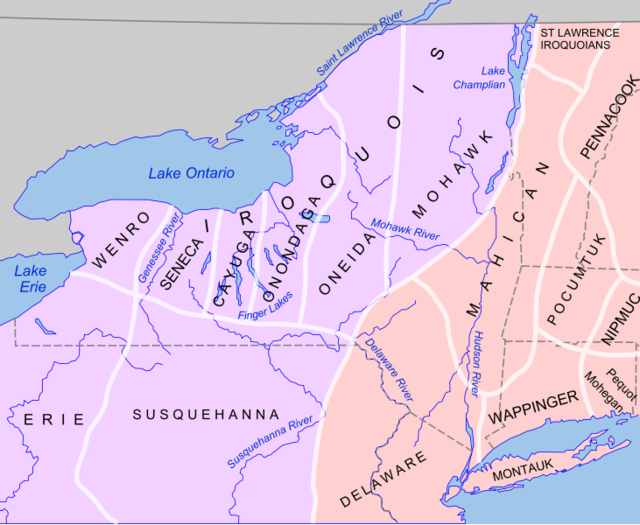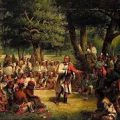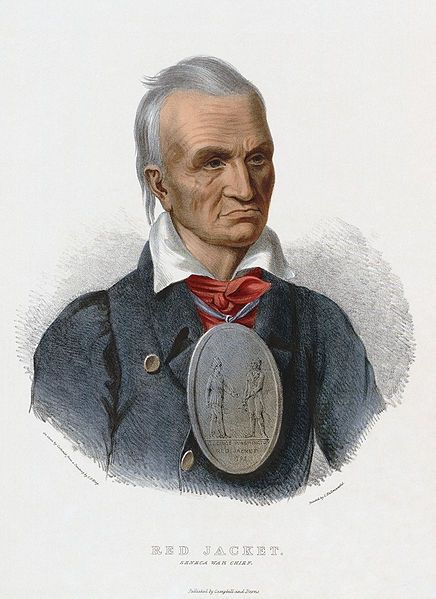Around the year 1451 five Iroquois nations—the Seneca, Cayuga, Onondaga, Oneida, and Mohawk—met to form the confederacy envisioned by the Huron prophet Deganawida. The five nations buried the instruments of war and planted a pine tree of peace. By 1700, the Iroquois Confederacy, commonly known as the League of Five Nations, was in between two rival European nations: the French and the English.

To the north of the Iroquois, the French sought to establish trading relations with the Indian nations, including the Iroquois. The French, who often spoke Indian languages, married Indian women, and dressed in Indian style, did not require their Indian business partners to change their cultures.
On the other hand the English, who occupied lands to the south and to the east of the Iroquois, felt that the extermination of the Indians, or at least of Indian cultures, was necessary to “tame the wilderness.” The English rarely spoke Indian languages, generally prohibited intermarriage with Indians, and viewed Indian religions as a form of “devil worship.”
The French and the English were traditional enemies, often fighting a religious war. The English, who were Protestants, strongly opposed French Catholicism which they viewed as an atheistic, evil religion.
In 1700, three French ambassadors traveled to Onondaga to speak to the Council of the League of Five Nations. They told the Iroquois that it was time for peace and that they wished to exchange prisoners and to place a Jesuit mission in Iroquoia. The sachems (a sachem is a chief in the Northeastern Indian nations) agreed to send a delegation to Canada to arrange for the peace and for the exchange of prisoners, but they would not agree to accept a Jesuit mission.
When the Iroquois attempted to release their French prisoners, however, many refused repatriation. They had been adopted into Iroquois families and refused to abandon their new lives. Only 13 French captives agreed to return.
Upon hearing about the French delegation to the Five Nations, the English governor of New York sent a representative to the Council to tell the Iroquois not to be deceived by the French. The Indians perceived the English message as one that challenged their sovereignty and implied that the English looked upon them as subjects.
The Iroquois felt that they could work the animosity between the French and English to their own advantage. In 1701, the Iroquois made two treaties: one with the British in Albany and one with the French in Montreal. These treaties began a policy of armed neutrality between the two contending European powers. In the treaty with the British, the sovereignty of the Five Nations over a vast tract of land along the shores of Lake Erie and Lake Huron was recognized. The King of England guaranteed Iroquois hunting in that area for their heirs and descendants forever. The Great Peace treaty with the French included 31 other Indian nations who were allied with the French. The two treaties marked the beginning of a period of material prosperity for the Iroquois. The Iroquois allowed trading posts only at the borders of their territories.
In 1702, war broke out between the French and the English in the form of Queen Anne’s War (War of Spanish Succession). Both the French and the English sought to keep the Iroquois neutral in this conflict so that the fur trade would not be interrupted. By remaining neutral, the Iroquois continued to trade with both and to maintain their dominant position in the fur trade.
In 1709, the British Governor met with four of the Five Nations (all except for the Seneca) to renew the Covenant Chain. The British told the Iroquois that they wanted them to take part in a military expedition against Canada. The Iroquois agreed to provide the British with 150 Mohawk, 105 Oneida, 100 Cayuga, and 88 Onondaga. However, the English war ships never arrived to supply the invasion and the war fizzled out before it began.
In 1710, Fort Hunter was built by the English in Mohawk territory. A wooden chapel was built within the fort and Queen Anne gave it a set of communion plates. The building of the chapel marked an intensification of Protestant missionary activity in the region. The following year, the Society for the Propagation of the Gospel in Foreign Parts sent a missionary to Fort Hunter to convert the Mohawk.
In 1712, the Iroquois Five Nations received wampum belts from the Tuscarora in the Carolinas. The Tuscarora asked for help in fighting the Catawba and the Virginia and Carolina colonists. When the governor of New York heard of the request, he warned the Iroquois not to get involved. The Iroquois promised to ask the Tuscarora to stop fighting if the governor asked the colonists to put down their arms. The French, however, convinced the Iroquois to send some warriors to aid the Tuscarora.
Queen Anne’s War between the French and English ended with the Treaty of Utrecht in 1713. Under this treaty, the Iroquois were considered British subjects and trade was permitted with the western Indians by both the British and the French.




Leave a Reply